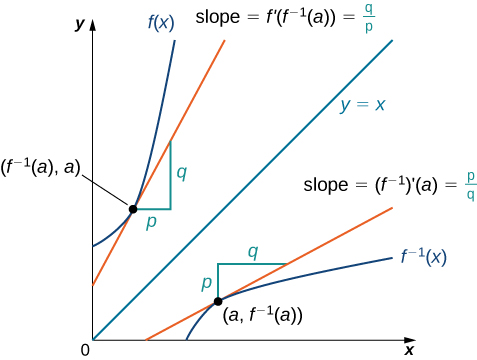| << Chapter < Page | Chapter >> Page > |
In this section we explore the relationship between the derivative of a function and the derivative of its inverse. For functions whose derivatives we already know, we can use this relationship to find derivatives of inverses without having to use the limit definition of the derivative. In particular, we will apply the formula for derivatives of inverse functions to trigonometric functions. This formula may also be used to extend the power rule to rational exponents.
We begin by considering a function and its inverse. If is both invertible and differentiable, it seems reasonable that the inverse of is also differentiable. [link] shows the relationship between a function and its inverse Look at the point on the graph of having a tangent line with a slope of This point corresponds to a point on the graph of having a tangent line with a slope of Thus, if is differentiable at then it must be the case that

We may also derive the formula for the derivative of the inverse by first recalling that Then by differentiating both sides of this equation (using the chain rule on the right), we obtain
Solving for we obtain
We summarize this result in the following theorem.
Let be a function that is both invertible and differentiable. Let be the inverse of For all satisfying
Alternatively, if is the inverse of then
Use the inverse function theorem to find the derivative of Compare the resulting derivative to that obtained by differentiating the function directly.
The inverse of is Since begin by finding Thus,
Finally,
We can verify that this is the correct derivative by applying the quotient rule to to obtain
Use the inverse function theorem to find the derivative of Compare the result obtained by differentiating directly.
Use the inverse function theorem to find the derivative of
The function is the inverse of the function Since begin by finding Thus,
Finally,
Find the derivative of by applying the inverse function theorem.
From the previous example, we see that we can use the inverse function theorem to extend the power rule to exponents of the form where is a positive integer. This extension will ultimately allow us to differentiate where is any rational number.

Notification Switch
Would you like to follow the 'Calculus volume 1' conversation and receive update notifications?